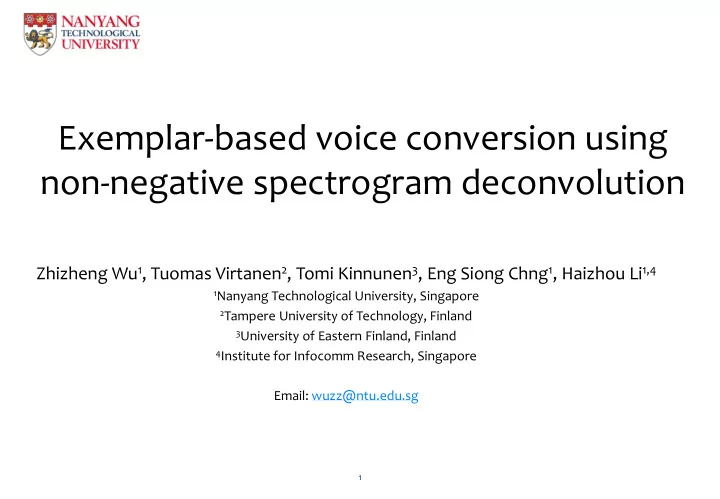

Exemplar-based voice conversion using non-negative spectrogram deconvolution Zhizheng Wu 1 , Tuomas Virtanen 2 , Tomi Kinnunen 3 , Eng Siong Chng 1 , Haizhou Li 1,4 1 Nanyang Technological University, Singapore 2 Tampere University of Technology, Finland 3 University of Eastern Finland, Finland 4 Institute for Infocomm Research, Singapore Email: wuzz@ntu.edu.sg 1
Introduction of voice conversion Techniques for modifying the para-linguistic information ( speaker identity, speaking styles, and so on ) while keeping linguistic information ( language content ) unchanged. Hello world Hello world Voice conversion Source speaker’s voice Target speaker’s voice 2
Baseline method JD-GMM: joint density Gaussian mixture model Joint probability density Conversion function: is the posteriori probability of x belong to k th Gaussian component 3
Problems in JD-GMM Statistical average Estimation of mean and covariance Average over all the 0.2 training samples 5 0.15 10 0.1 15 20 Dimension 0.05 25 0 30 35 -0.05 40 -0.1 45 5 10 15 20 25 30 35 40 45 Dimension 4
Motivation Avoid estimating covariance matrix which usually ‘bad’ estimated To transform relative high-dimensional spectral envelopes directly Include temporal constraint in generation of spectrogram 5
Non-negative spectrogram factorization (NMF) Basic idea: to represent magnitude spectra as a linear combination of a set of basis spectra (speech atoms) NMF for voice conversion X and Y are source and converted spectrograms, respectively A ( X ) and A ( Y ) are source and target exemplar dictionaries, respectively H is the activation matrix, column vector, h , of H consists of non-negative weights 6
Non-negative spectrogram factorization (NMF) Illustration of NMF 7
Non-negative spectrogram deconvolution (NMD) The idea: to include temporal constraint in the estimation of activation matrix and also the generation of spectrogram Formulation: and are the matrices consisting of the frame of the source and target atoms, respectively L is the number of adjacent frames within an exemplar operator shifts the matrix entries (columns) to the right by unit 8
Features Magnitude spectrum (MSP): use 513-dimenaional spectral envelope extracted by STRAIGHT. We use MSP to reconstruct speech signal. Mel-scale magnitude spectrum (MMSP): pass MSP to a 23-channel Mel- scale filter-bank. The minimum frequency is set to be 133.33 Hz, and the maximum frequency is set to be 6,855.5 Hz. Mel-cepstral coefficient (MCC): MCC is obtained by employing mel- cepstral analysis on magnitude spectrum and keeping 24 coefficients as the feature 9
Dictionary construction Processes to build source and target dictionaries Extract magnitude spectrograms (MSP) using STRAIGHT; Apply Mel-cepstral analysis on MSP to obtain Mel-cepstral coefficients (MCCs); Apply 23-channel Mel-scale filter-bank on the spectrograms to obtain 23- dimensional Mel-scale magnitude spectra (MMSP); Perform dynamic time warping (DTW) to the source and target MCC sequence to align source and target speech to obtain source-target frame pairs; Apply the alignment information to the source MMSP (or MSP) and target MSP. The resulting spectrum pairs are stored in the source and target dictionaries (column vectors), respectively. 10
Experimental setups Corpus VOICES database: parallel corpus Male-to-female and female-to-male conversions are conducted 10 utterances from each speaker are used as training set 20 utterances from each speaker as testing set Fundamental frequency (F0) is converted by equalizing the means and variances of source and target speaker in log-scale. 11
Objective evaluation measure Mel-cepstral distortion: calculation is done frame-by-frame Correlation coefficient: calculation is done dimension-by-dimension and are the d th dimension feature of the m th frame original target and converted MCC vector, respectively. and are the mean values of the d th dimension original target and converted MCC trajectories, respectively. 12
Experimental results Comparison of NMF using 513-dimension MSP and 23-dimensional MMSP in the source dictionary Spectral distortion and correlation results as a function of the window size of an exemplar 23-dimensional MMSP yields lower MCD and higher correlation coefficient than 513-dimensional MSP 13
Experimental results Spectral distortion and correlation results comparison of JD-GMM, NMF and NMD methods as a function of the window size of an exemplar. 1, Both NMF and NMD obtain lower distortion and higher correlation than JD-GMM. 2, NMD method obtains higher correlation than NMF method. 14
Subjective evaluation results Preference score with 95% confidence interval for speaker similarity Both NMF and NMD outperform JD-GMM method! Converted speech quality? Listen to our demo! 15
Conclusions We proposed an exemplar-based voice conversion method utilizing the matrix/spectrogram factorization techniques. Both non-negative spectrogram factorization and non-negative spectrogram deconvolution are implemented to use original target spectrogram directly without any dimension reduction to synthesize the converted speech. NMF and NMD both outperforms the conventional JD-GMM method. 16
Recommend
More recommend